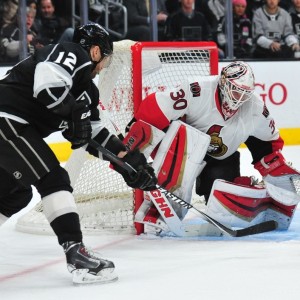Barring the team-wide disaster that was the Ottawa Senators’ 7-1 loss to the Washington Capitals, Andrew Hammond has been a pleasant surprise for the Senators this year. While many commentators cast doubt on his suitability as an NHL level goalie – myself included – Hammond has so far this season been a quality back-up for Craig Anderson. Even including letting seven goals in last week against the Capitals, Hammond has posted a respectable 2.82 GAA and a 912 SV%. While not starters’ numbers, he has been reliable enough to provide Ottawa with a quality back-up goalie at a very reasonable cap hit of $1.35 million per year. But how can we explain Hammond’s remarkable transformation from AHL failure to NHL goalie in the space of a year? Certainly his strong work ethic and Ottawa’s coaching staff are partly responsible for his rapid development. But if we look at the underlying numbers, the Senators as a team are also much more defensively responsible when Hammond is in nets.
Ottawa Protects Andrew Hammond

Craig Anderson’s consistently good to great form since Ottawa acquired him in early spring of 2010 clearly inspires confidence in Senators’ players. So much so that they are frequently willing to hang Anderson out to dry, relying on him to stop a league-high number of shots each night. Over the past season and a half, among goalies who have played in more than 30 games, Anderson has faced the third most shots on average per game. Only Toronto Maple Leafs’ James Reimer and Philadelphia Flyers’ Michal Neuvirth – who played most of last season with the truly awful Buffalo Sabers – have faced more shots per sixty minutes of ice time than Anderson.
It is then truly surprising to find Andrew Hammond fifteenth on the list, only slightly above Cory Crawford and Petr Mrazek, both starting goalies for teams often celebrated for their excellent defensive play. Let me illustrate how substantial a change in shots against per game this is. Since the start of 2014, Anderson has faced 32.82 shots per game on average, which corresponds closely – 0.2 off – to Ottawa’s shots against for the same time period. The 33 shots per game Ottawa give up ranks them third worst in the league over that time, behind only Buffalo and Toronto. Alternatively, Hammond has faced an average of 30.7 shots per game, almost a full two less than Anderson. If Ottawa limited shots against when playing in front of Anderson the way though do when playing in front of Hammond, the Senators would only be much closer to Stanley Cup Champions Chicago than basement dwellers Buffalo in terms of shots given up. While still in the bottom half of the league, they would be close to perennial playoff teams Pittsburg, Chicago and the New York Rangers; an important improvement for a playoff bubble team like Ottawa.
If we dig into these numbers a little more, the thesis that Ottawa plays better defensively in front of Hammond than Anderson holds up. Looking at goalie numbers from the past two years on puckanalytics.com, Ottawa is a better puck possession team when Hammond starts. With Anderson in net Ottawa gives up 44.5 Unblocked shot attempts (Fenwick) and 58.17 blocked shot attempts (Corsi) per sixty minutes of even strength game time. Comparably, when Hammond starts, Ottawa’s Fenwick against is 42.2 and their Corsi against is 55.7. Generalizing from these numbers, it is clear that Ottawa is better at suppressing shot attempts when Hammond plays. The obvious question is why?
Seeking An Explanation
Given that the data I’ve examined includes all of last year’s miracle run, the easy explanation of “backup goalies get easy games” doesn’t apply in this case. Even in the playoffs against Montreal last year, Ottawa gave up more shots when Craig Anderson started than when Andrew Hammond did. An alternative explanation is Ottawa plays more conservatively with Hammond in nets because he does not play in a way that inspires confidence. Watch the video below for evidence to support this supposition:
Yes, this is an amazing save, but to call it orthodox would be a stretch. Hammond has phenomenal athleticism and reflexes and his lateral movement may well be the best of any goalie in the league. However, he is often forced to rely on his athletic ability to make saves when his positioning and puck tracking fail him. In this respect, he is a very similar goalie to sometimes Winnipeg Jets starter Ondrej Pavelec; capable of highlight reel saves but positionally questionable. One possible explanation for Ottawa’s much-improved defense when Hammond plays is that the Senators collectively may well be unwilling take the same chances with the puck when Anderson is on the bench.
Regardless, it is imperative that Ottawa coach Dave Cameron figure out what the difference is. The Senators give up far to many shots and whileW I’ve argued before that trading for a high-quality defenseman would help remedy this situation, Bryan Murray, not Dave Cameron, is the one making trades in Ottawa. As the Andrew Hammond vs. Craig Anderson comparison demonstrates, Ottawa can limit shots against through a change in playing style/tactics. Dave Cameron has also done it before, as after taking over from Paul Maclean in December of 2014, Ottawa drastically reduced their shots against, leading to a remarkable run and a wildcard spot. So, for the sake of Ottawa fans everywhere, let us hope that Cameron and the coaching staff watch tapes of games Hammond starts and gets the team to support their starting goalie the way they do their backup. The playoffs probably depend on it.